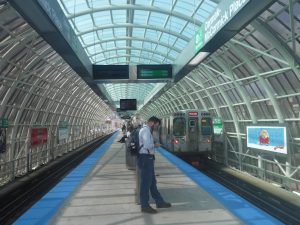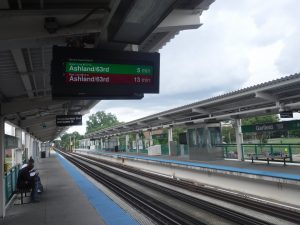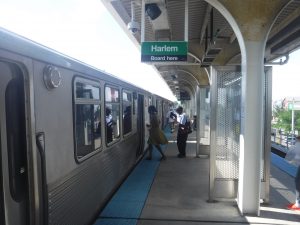CTA boosts rush-hour service on Green Line
By Igor Studenkov For Chronicle Media — July 18, 2017
Red Line train to Howard leaves Cermak-McCormick Place Green Line L station. (Photo by Igor Studenkov/for Chronicle Media)
As the Chicago Transit Authority works to expand 95th/Dan Ryan L station, Red Line’s southern terminal, it sent some of the trains that would normally serve it to the nearby Green Line.
Instead of traveling between Howard to 95th/Dan Ryan station, some rush-hour trains now move to the Green Line after reaching the Roosevelt L station.
While this reduced the number of trains on the southern portion of the Red Line, it increased service on the Green Line. This was especially evident at Halsted/63rd and Ashland/63rd stations, which usually get less service than the stations further north. However, most of those extra rush-hour trains traveled in the opposite direction of the regular commuting patterns. And it’s not entirely clear just how much the riders actually benefited in the process.
Today, the Red Line is made up of three segments — the Dan Ryan branch, the State Street Subway and the section of the North Side Main Line between Armitage and Howard L stations. But that arrangement is actually relatively recent. Between 1913 and 1993, the north-south service used what is now the south portion of the Green Line. At first, the trains went from the line’s branches, over the Loop tracks, down North Side Main Line tracks that are now portions of the Brown Line until Armitage, where it followed the path riders know today. When the State Street Subway opened in 1943, the trains were redirected there. And when the Dan Ryan Subway opened in 1969, the new line was connected to what is now the portion of the Green Line running between Roosevelt and Harlem L stations.
In 1990s, CTA decided to create the Red and Green lines as they are known today due to ridership. At the time, it was felt that Dan Ryan branch, the State Street Subway and North Side Main Line would work better as one line because they had bigger ridership than the segments that would become the Green Line.

CTA train tracker at Garfield Green Line station shows Red Line and Green Line trains arriving in a few minutes. (Photo by Igor Studenkov/for Chronicle Media)
Even after the service change, CTA never did away with the older track connections. When, in 2013, the transit agency shut down Dan Ryan Branch for the complete rehabilitation, the Red Line trains were rerouted onto the Green Line, because it runs parallel to the Red Line between Cermak Road and Garfield Boulevard. CTA used free shuttle buses to transport riders between Garfield Green Line L station and the Red Line stations further south.
In 2014, CTA launched an extensive renovation of the 95th/Dan Ryan station. Aside from serving as the line’s southern terminal, it acts as a major area transit hub for CTA and Pace buses and a stop many Greyhound and Indian Trails intercity buses heading south and east. The plan calls for the existing terminal building on the north side of 95th Street to be replaced by a larger facility, and for a second building to be built on the south side of the street. The buses would use both buildings, reducing congestion, and an overhead walkway would connect both buildings, making it easier for riders to cross the busy street below.
As part of the project, the agency needed to rebuild tracks and add support structures for the expanded northern terminal. While normally, two trains can use the station at the time, the construction work required it to keep one of the tracks closed. As CTA explained on the project page, this would become an issue during rush hours, where trains run much more frequently, forcing some trains to wait for tracks to free up.
Related: Classic buses spotlighted for CTA’s 70th anniversary
As the result, CTA decided to reroute some of the inbound and outbound trains onto the Green Line, sending them between Roosevelt and Ashland/63rd Street stations. This affects morning trains running between 7:56-9:14 a.m., and afternoon trains running between 4:14-5:58 p.m. The exact schedule varies, but they follow a similar pattern. In the morning, the trains heading toward Ashland/63rd station run an average of once every six minutes, while the trains heading to Howard run an average of once every 12 minutes. The pattern flips during the afternoon rush hours.
This reroute had a side-effect of boosting the service along the south portion of the Green Line. Under the regular schedule, Green Line trains run once every 7-10 minutes during the rush hour. By comparison Red Line trains run every 3-6 minutes during the same period,
The rerouted Red Line trips add six extra northbound trains and fifteen extra southbound trains during the morning rush hour, and 15 extra northbound trains and five extra southbound trains during the evening rush hour.
The arrangement only mildly benefits most commuters, who tend to travel toward downtown in the mornings and away from downtown in the evenings. It would have the most effect on riders traveling to South Side destinations such as the Illinois Institute of Technology, the McCormick Place and Kennedy-King College.
The effect is more noticeable south of Garfield station, where the line splits into Ashland and East/63rd branches. Normally, the Green Line trains alternative — if one train goes down the Ashland branch, the next one goes to the other branch, and so one. This means that half as many trains go down each branch as the rest of the line. But the Red Line trains running on Ashland branch now help make up for it. During the rush hour, the branch’s Halsted/63rd station gets four downtown-bound trains an hour. Between 8:40-10 a.m., the Red Line trains bump that number up to six to seven. And while only three to four southbound trains per hour serve that station in the afternoon rush hour, between 4:20-4:56 p.m., the Red Line trains bump that number up to six.
The Ashland branch serves the section of Englewood neighborhood that has received some development in recent years. The neighborhood’s Whole Foods location, which opened in September 2016, is within walking distance of Halsted/63rd station, as is the Starbucks location that opened near the grocery store.
The Red Line trains also offer a one-seat service between the South Side and destinations throughout the North Side. However, it should be noted that, even without the rerouted service, riders can easily transfer between Red and Green lines at the Roosevelt station. This reporter’s observations at Roosevelt and Cermak-McCormick Place station — the first Green Line station after Roosevelt — suggest that some riders do take advantage, but it isn’t clear how many of those riders would have otherwise simply made a transfer.

Afternoon commuters board the Red Line train to Howard at 35th-Bronzeville-IIT Green Line L station. (Photo by Igor Studenkov/for Chronicle Media)
CTA spokesperson Catherine Hosinski said the agency counts ridership based on where the passengers boarded. As the result, it has no way of knowing how many riders who, for example, boarded at Halsted/63rd took the Green Line and how many riders took the Red Line.
“Anecdotally, though, based on the limited information that is available, it appears that ridership patterns at the affected stations are normal,” she added.
During the afternoon rush hour trains at the Cermak-McCormick Place on June 21 and 22, southbound Red Line trains tended to have about half as many riders as southbound Green Line trains.
It is not entirely clear just how much demand there is for more service — at least on the main line.
Christian Sanchez is a barista at Currency Exchange Cafe, which is located almost directly across the street from Garfield station entrance. She said that the proximity to the Green Line is important to the cafe.
“It’s the link between us and the downtown,” she said.
When asked if the Red Line reroute had any effect on the business, she said that she hadn’t noticed any. And, generally speaking, she was happy with the Green Line schedule.
“It’s a good pace for a schedule,” Sanchez said. “It’s never too long [of a wait].”
Hosinski said that the reroute will remain the place until the second phase of the 95th/Dan Ryan station, which is expected to happen sometime in the early 2018.
On the long term, CTA is hoping to expand the Red Line beyond 95th/Dan Ryan, toward 130th Street. It would mostly follow a Union Pacific Railroad freight line near Egglestone Avenue until 119th Street, and follow the South Shore Line right-of-way the rest of the way. If completed, it would mark the first time riders would be able to take the L to Chicago’s southern city limits.
Hosinski emphasized that the 95th/Dan Ryan rebuilding project and the Red Line extension weren’t dependent on each other.
“Even when the Red Line Extension is completed, the 95th/Dan Ryan Terminal will continue to be a major bus and rail hub for thousands of daily passengers,” she said. “The 95th/Dan Ryan Terminal Renovation represents a near-term improvement to an existing terminal, while the Red Line Extension continues to seek funding for its construction.”
At the moment, one major issue needs to be decided is whether the elevated tracks will be located to the right of the tracks or to the left of it.
“We anticipate announcing a final alignment this year for the project, following community meetings held last fall on the two proposed alignments that are under consideration,” Hosinski said.
Read the current issue of the Cook County Chronicle
Free subscription to the digital edition of the Cook County Chronicle
— CTA boosts rush-hour service on Green Line —







